
Exploring the Classic Macintosh Game: Bub & Bob
Fun Game to Play on the Classic Macintosh
If you're a fan of retro gaming, you might have come across the classic arcade game "Bubble Bobble," which was also available on platforms like the Commodore 64, Atari ST, and Amiga. But did you know that there's a Macintosh game called "Bub & Bob" that's a 90% clone of "Bubble Bobble"? Let's dive into the nostalgic world of "Bub & Bob" and see what makes it so special.
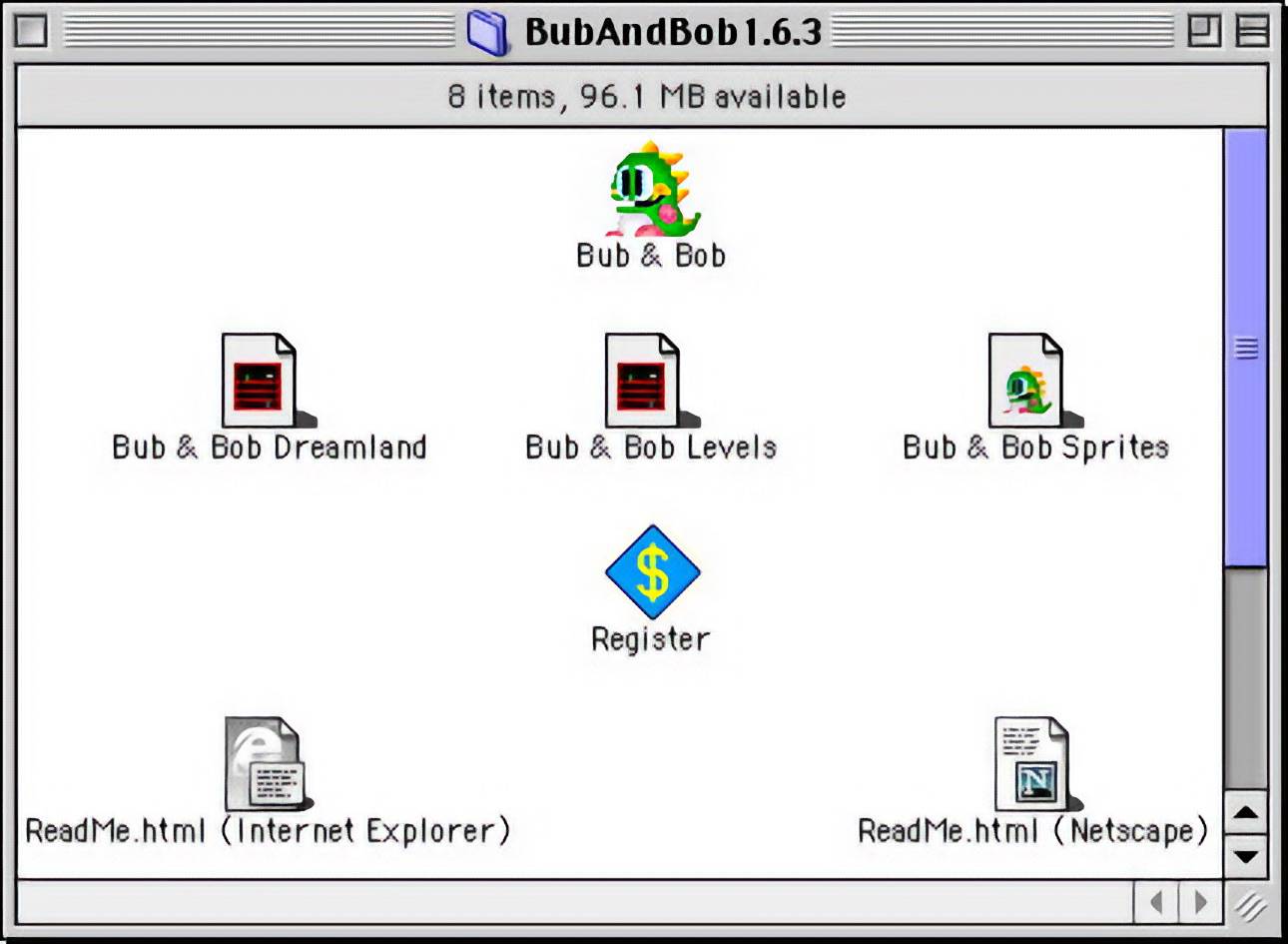
The Basics of "Bub & Bob"
In "Bub & Bob," you play as a little green or blue dinosaur, reminiscent of the characters from "Bubble Bobble." Your main objective is to catch your enemies by shooting bubbles at them. Once trapped in a bubble, you can burst them with your back thorns, turning them into fruits. This simple yet addictive gameplay mechanic is what makes "Bub & Bob" so engaging.
Power-Ups and Enhancements
One of the exciting aspects of "Bub & Bob" is the variety of power-ups and extras available to enhance your abilities. These power-ups can include fast shots, speed boosts, and other enhancements that make the game even more thrilling. Collecting these power-ups adds an extra layer of strategy and fun to the gameplay.
Cooperative Play
Perhaps the best feature of "Bub & Bob" is the ability for two players to play together. This cooperative mode allows you and a friend to team up and tackle the game's challenges together. The camaraderie and teamwork required in this mode make "Bub & Bob" a fantastic game for social gaming sessions.
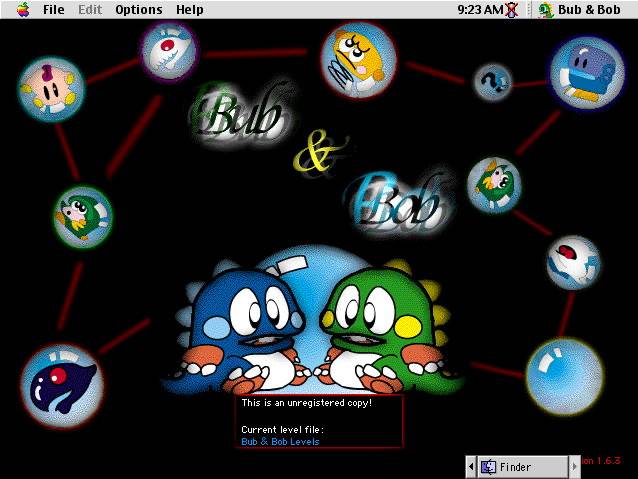
A Nostalgic Trip Down Memory Lane
"Bub & Bob" is a delightful trip down memory lane for anyone who enjoyed "Bubble Bobble" or other classic arcade games. Its charming graphics, engaging gameplay, and cooperative mode make it a standout title in the world of classic Macintosh games. Whether you're a retro gaming enthusiast or just looking for a fun game to play with a friend, "Bub & Bob" is definitely worth checking out.
So, dust off that old Macintosh, grab a friend, and get ready to catch some enemies in bubbles with "Bub & Bob"!
PermalinkPeter Ferrante Comments
Comments in some RAW HTML files in 1999
I was searching through some old files on my WallStreet G3 laptop and I found a folder called Web Pages. This contained several files around Apple's Personal WebSharing.

What is Mac OS Personal Web Sharing
Mac OS Personal Web Sharing is the easiest way to share your information with others on your intranet, no matter what type of computer or browser they're using. All you do is put the items you want to share in the Web Pages folder and turn on Web Sharing.
As long as your computer is connected to a TCP/IP network (intranet or Internet) and your server is running (turned on in the Web Sharing control panel), the server's content is available to users of the network. You control what items are shared and who can see those items, by using the standard Mac OS file sharing privileges. You can specify who has access to items and assign a password to some or all of your Web server's content.
Interesting Easter Egg
I was checking the raw source code and discovered that Peter Joseph Ferrante left some interesting comments in the header of some of the Mac OS Personal Web Sharing files.
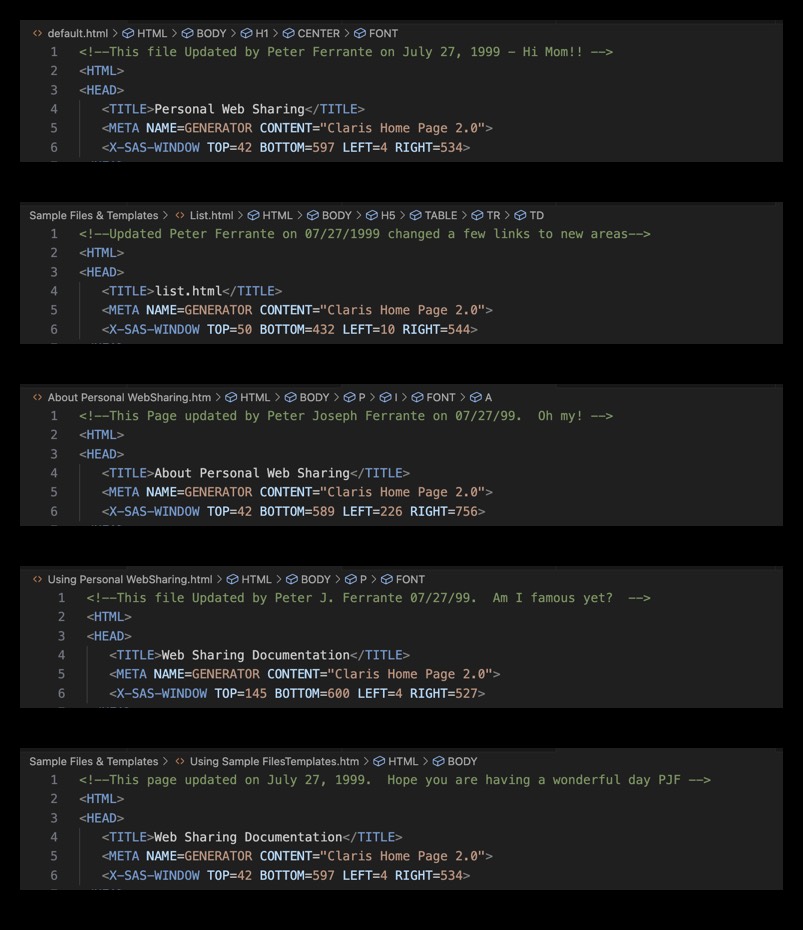
I bet that he didn't think anyone would ever check the raw HTML.
Yes, Peter Joseph Ferrante, your famous now that your comments appeared on cryan.com website blog!
PermalinkBlast from the Past: HackUser
The Controversial Macintosh Utility That Kept Old Software Alive
Hello, fellow Macintosh enthusiasts! Welcome to this week's edition of "Retro Mac Rewind," where we dive into the quirky, controversial, and sometimes forgotten corners of Macintosh history. Today, we're turning back the clock to November 1998 to explore a utility that had the Macintosh community buzzing: HackUser.
In the late '90s, as software was evolving at a breakneck pace, many Mac users found themselves with a library of older programs they couldn't bear to part with. Enter HackUser, a tool that promised to breathe new life into aging software by providing a vast database of serial numbers and cracks.
Now, before we go further, let's address the elephant in the room: HackUser operated in a legal and ethical gray area. It's important to note that using software without proper licensing is generally not legal or ethical. However, HackUser's creators positioned their tool as a means of preservation rather than piracy.
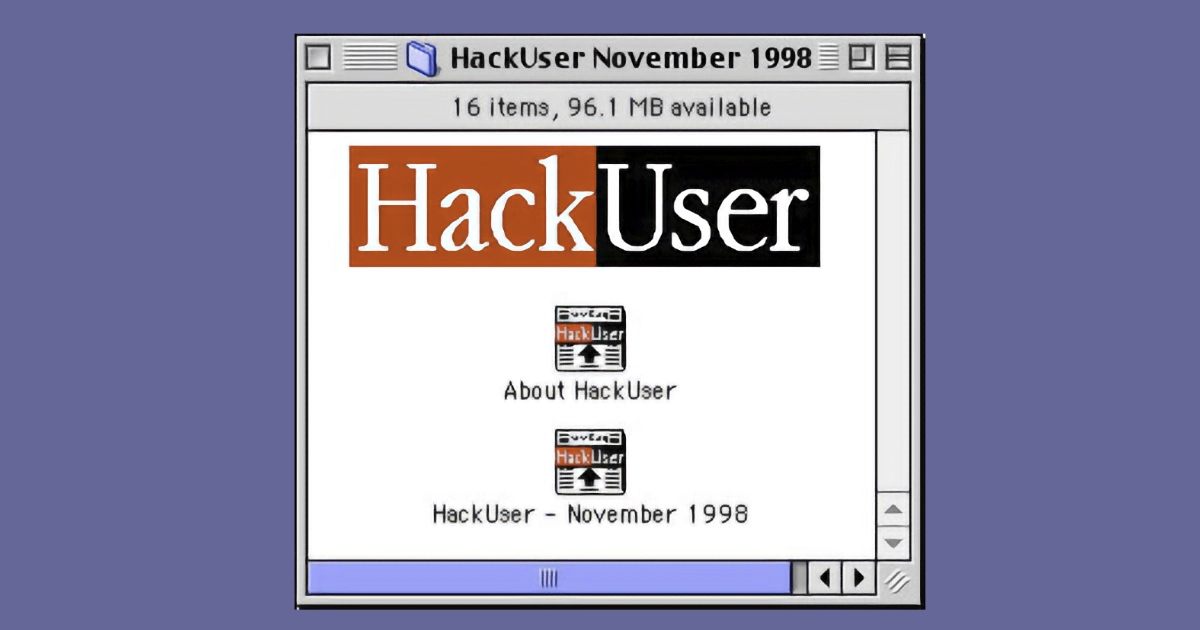
Use Your Old Software Again.
The HackUser team described their mission as archiving old serial numbers that were often purged from other databases to make room for newer software. They saw themselves as digital archaeologists, preserving access to software that might otherwise be lost to time.
What made HackUser unique was its comprehensive approach. The creators compiled serial numbers and cracks from various sources, crediting contributors like "The Informant," "Hackers Helper," "Buck's Cracks," and "Zeus." This collaborative effort resulted in what they claimed was the most extensive serial number database available at the time.
HackUser releases were eagerly anticipated by a subset of the Mac community. Each monthly issue promised growth "at a phenomenal rate," with a "What's New?" section catering to those seeking the latest additions.
Product Description
About HackUser
Welcome the the new issue of HackUser. These issues are based on all the serial numbers and cracks applications made from others and combined into one. Special thanks to The Informant, Hackers Helper, Buck's Cracks, Zeus and all the people who made it possible to archive these. These issues were not made to compete with others, but to provide old serial numbers. We decided to make these issues because of the fact that that other serial number archives sometimes delete the old serial numbers to make room for new ones. At a time when you need one it becomes very difficult to find old versions. We at HackUser hope this helps. We will include a "Whats New?" in every issue for all those who want the latest and greatest. This issue will grow at a phenomenal rate each month so make sure you always have the latest issue.These issues of HackUser have more codes than any other serial number database. You can use these serial numbers to make a application usable if it requires a serial number to run. You can also use these serial numbers to order upgrades and competitive upgrades from catalogs and stores.
If you have any new serial numbers or any questions get in touch with a member of HackUser Corporation.
To Use This Archive:
To find a serial number. Go to the menu and select "find". Type name of the program, company or part of the name of the program. Press Enter. If the program is not found in the search press enter again to go to the next item or change the subject of the search.
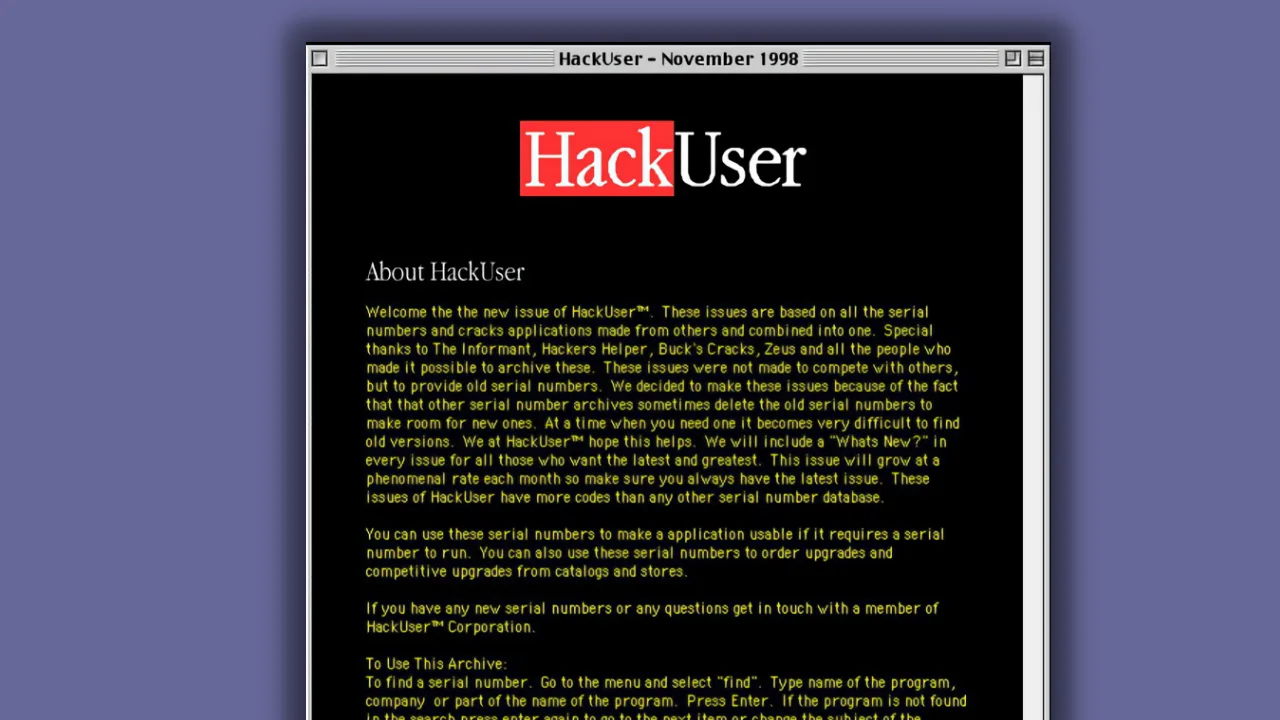
About HackUser Page
More Than Just Rebooting Old Software
But HackUser wasn't just about running old software; it also provided a pathway for users to order upgrades or competitive upgrades from catalogs and stores. In a time before widespread digital distribution, this feature helped users navigate the complex world of software licensing and upgrades.
Useful Tool
Looking back, HackUser represents a fascinating moment in Macintosh history. It highlights the community's desire to preserve and continue using older software, even as the platform rapidly evolved. It also underscores the complex relationship between users, developers, and the concept of software ownership.
While we can't condone the use of unlicensed software, HackUser serves as a reminder of the passion and ingenuity of the Macintosh community. It's a testament to the enduring appeal of classic Mac software and the lengths to which enthusiasts would go to keep their beloved programs running.
As we reflect on utilities like HackUser, it's worth considering how far we've come in terms of software preservation and backwards compatibility. Today, initiatives like the Internet Archive's software library provide legal ways to experience classic software, while Apple's own efforts have made transitioning between system versions smoother than ever.
Your Thoughts?
What are your thoughts on HackUser and similar utilities from the '90s? Did you ever use them to keep your favorite old programs running? Share your experiences in the comments below, and join us next week for another journey into Macintosh history!
Remember, folks: always respect intellectual property rights and support software developers by purchasing and using software legally. Happy computing!
PermalinkRediscovering the eWorld Font
A Journey Through Apple's Lost Typeface
As a tech enthusiast and font aficionado, I recently embarked on a nostalgic journey that led me to unearth a piece of Apple's forgotten history: the eWorld font. This elusive typeface, once integral to Apple's short-lived online service in the mid-1990s, has become something of a digital artifact. Today, I'm sharing my adventure in attempting to resurrect this piece of typographic history.
The Discovery
It all started when I managed to get my hands on an original installation floppy disk containing the eWorld font. The date stamp on the font file read April 28, 1994. Excitement coursed through me as I held this piece of Apple's past in my hands. Also on the floppy disk were Monoco (May 16, 1994) and Palatino (May 111, 1994).
The Challenge
However, my initial enthusiasm was quickly tempered by reality. Despite having the font file, I found myself unable to install it on my modern system. It was a stark reminder of how quickly technology moves forward, often leaving behind compatibility with older software.
A Glimpse into the Past
Undeterred, I turned to my trusty G4 computer - a relic in its own right, but newer than the eWorld era. While I couldn't install the font, I was able to preview it.
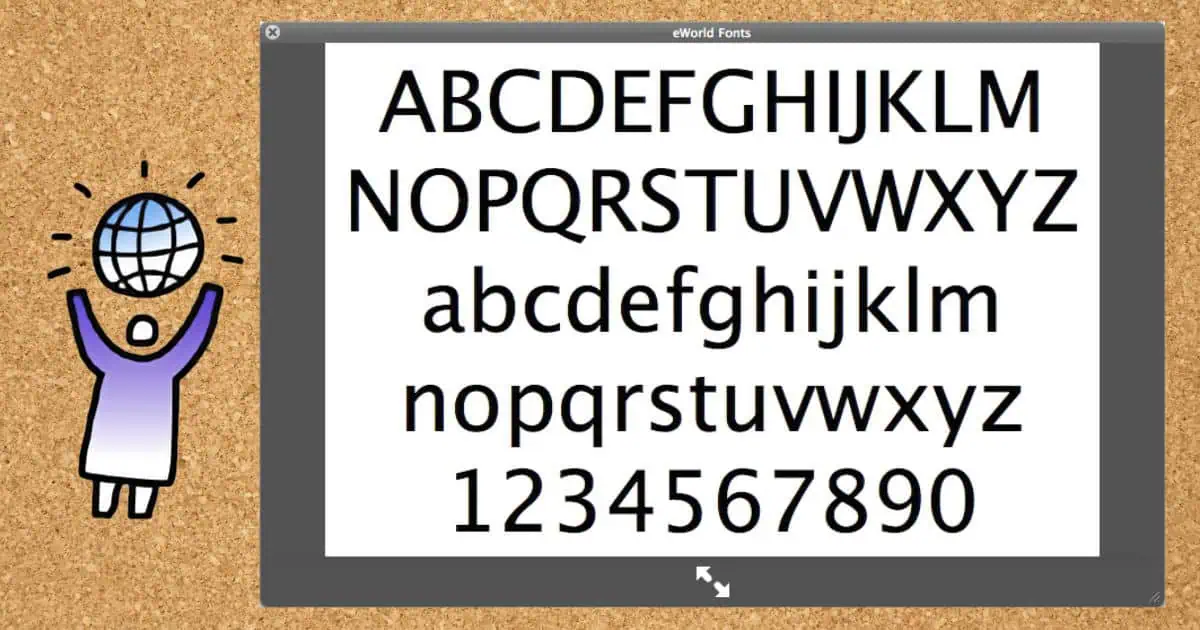
Looking at the preview, I was struck by the font's clean lines and friendly appearance. It exuded a sense of approachability that was characteristic of Apple's design philosophy at the time.
Modern-Day Equivalents
Intrigued by what I saw, I began comparing the eWorld font to other typefaces in my collection. To my surprise, I found that two fonts bore a striking resemblance to eWorld:
- Lucida Grande
- Apple Symbols
These fonts, which have been staples in Apple's typographic arsenal for years, seemed to carry the DNA of their eWorld predecessor. It was fascinating to see how Apple's font design had evolved while maintaining certain core aesthetic principles.

Lucida Grande and Apple Symbols are very similar to the eWorld Font.
The Legacy of eWorld
While the eWorld online service was short-lived (1994-1996), its font appears to have had a lasting impact on Apple's typography. The similarities between eWorld and more recent Apple fonts suggest that the design principles behind eWorld - clarity, friendliness, and ease of reading - continued to influence Apple's typographic choices long after the service itself was discontinued.
Reflections
My journey with the eWorld font, from the excitement of discovery to the challenges of compatibility, serves as a reminder of the rapid pace of technological change. It also highlights the importance of digital preservation. Fonts, like other software, can become casualties of progress, existing only in the limbo of outdated file formats and incompatible systems.
For designers and tech historians, fonts like eWorld are more than just letters on a screen. They're windows into the aesthetic and functional priorities of their time. They tell us about the technology available, the design trends in vogue, and the ways in which companies like Apple sought to present themselves to the world.
Conclusion
While I may not have been able to fully resurrect the eWorld font, this experience has given me a deeper appreciation for the evolution of digital typography. It's a reminder that behind every letter we type is a rich history of design, technology, and cultural shifts.
For those interested in typography or Apple's history, I encourage you to look beyond the fonts we use every day. There's a whole world of forgotten typefaces out there, each with its own story to tell. Who knows what other typographic treasures are waiting to be rediscovered on old floppy disks and CD-ROMs?
Have you ever stumbled upon an old font or piece of software that fascinated you? I'd love to hear about your experiences in the comments below!
PermalinkDiscovering eWorld Floppy Disks
Why different versions?
While cleaning my office space, I stumbled upon a treasure trove of old floppy disks. Among them were two copies of eWorld version 1.0 floppies, one with a black and white label and the other with a color label. This discovery sparked a wave of nostalgia and curiosity about the history and significance of these disks.
The eWorld Experience
For those who might not be familiar, eWorld was an online service launched by Apple in 1994. It was designed to provide a user-friendly interface for accessing email, news, and other online services, much like AOL at the time. Despite its innovative approach, eWorld was short-lived, shutting down in 1996 due to limited adoption and competition from other online services.
The Mystery of the Labels
Finding two versions of the same software with different label designs got me thinking: Why did some eWorld disks have color labels while others were in black and white? Here are a few possibilities:
- Marketing and Presentation:
- The color labels might have been used for retail versions of the software to make them more visually appealing on store shelves. Colorful packaging often attracts more attention and can be a marketing strategy to boost sales.
- Cost and Production:
- Black and white labels could have been a cost-saving measure. Producing color labels is generally more expensive, so black and white labels might have been used for bulk distributions, such as those included with new hardware or given away at promotional events.
- Distribution Channels:
- It's possible that the black and white labeled disks were included with new Apple hardware as a bundled software package. This would make sense as a way to reduce costs while still providing users with the necessary software.
- Version Differentiation:
- Another possibility is that the different labels were used to differentiate between various distribution batches or regions. This could help in tracking and managing inventory more efficiently.
A Glimpse into the Past
Holding these eWorld floppy disks in my hands, I couldn't help but feel a sense of connection to a bygone era of technology. These disks are more than just pieces of plastic; they represent a time when the internet was still in its infancy, and companies like Apple were experimenting with new ways to bring people online.
If you have any old tech artifacts lying around, take a moment to appreciate their history and the stories they hold. You never know what fascinating insights you might uncover!
PermalinkMark III Shareware
A Trip Down Memory Lane
I recently embarked on a digital archaeology expedition through my old floppy disks, and I stumbled upon a treasure trove: an Educorp disk labeled "Mark III Shareware." For those unfamiliar with the term, "shareware" was essentially the early internet, allowing software developers to distribute their creations freely for trial before purchasing.

To decipher the contents of this relic, I had to consult my trusty Educorp catalog. Imagine my surprise when I discovered this single disk housed a whopping 10 applications! The mastermind behind this collection was Andrew Welch, a name that might ring a bell to those familiar with the early Mac scene, as he later founded Ambrosia Software.
This collection is a veritable goldmine for retro Mac enthusiasts. Here's a quick rundown of the software gems I found:
Black Box: A Feature-Packed System Enhancer
Think of Black Box as a Swiss Army knife for your Mac. It added a task strip (a precursor to the Dock), an analog clock, screen saver, and a host of keyboard shortcuts and system enhancements. It was like having a personal assistant for your computer, all packed into a single application.
Clarity: Photo Reduction Made Easy
In the days before digital cameras and high-resolution printers, resizing images was a challenge. Clarity stepped in to save the day, allowing users to easily reduce photo sizes to fit different printers.
Easy Envelopes Plus: Mail Made Simple
This DA (desktop accessory) streamlined the process of creating envelopes. From custom sizes to graphics and return addresses, Easy Envelopes Plus had it all.
FlashWrite: Quick and Dirty Note-Taking
A minimalist text editor that resided in the system, FlashWrite was perfect for jotting down quick notes or editing clipboard content.
Label Manager: Organize Your World
If you needed to print labels but didn't want to invest in a pricey database, Label Manager was your go-to solution. It supported various label sizes, printers, and offered sorting capabilities.
Memoir DA: Keep an Eye on Your Memory
A simple but essential tool, Memoir DA displayed your Mac's available memory, helping you manage resources effectively.
Optical: A Visual Diversion
While not strictly utilitarian, Optical offered a mesmerizing optical illusion to help you relax or simply enjoy a moment of visual intrigue.
ProFont: Crisp and Clear Text
Programmers and anyone working with text from other computers appreciated ProFont, which provided a truly monospaced typeface for consistent character spacing.
QuickCard: Phone Numbers at Your Fingertips
This CDEV (control panel device) made dialing phone numbers a breeze. You could quickly enter and store numbers, and even replay them through the Mac's speaker.
To Do! DA: Stay Organized
A timeless tool, To Do! DA helped you create, manage, and prioritize your tasks efficiently.
Discovering this forgotten treasure trove has been an absolute delight. It's a testament to the ingenuity and creativity of early software developers, and it offers a fascinating glimpse into the evolution of computer software.
Do you have any other old software gems you'd like to share?
PermalinkRediscovering MacWorld Tokyo 1995
A Journey Back in Time with a Floppy Disk
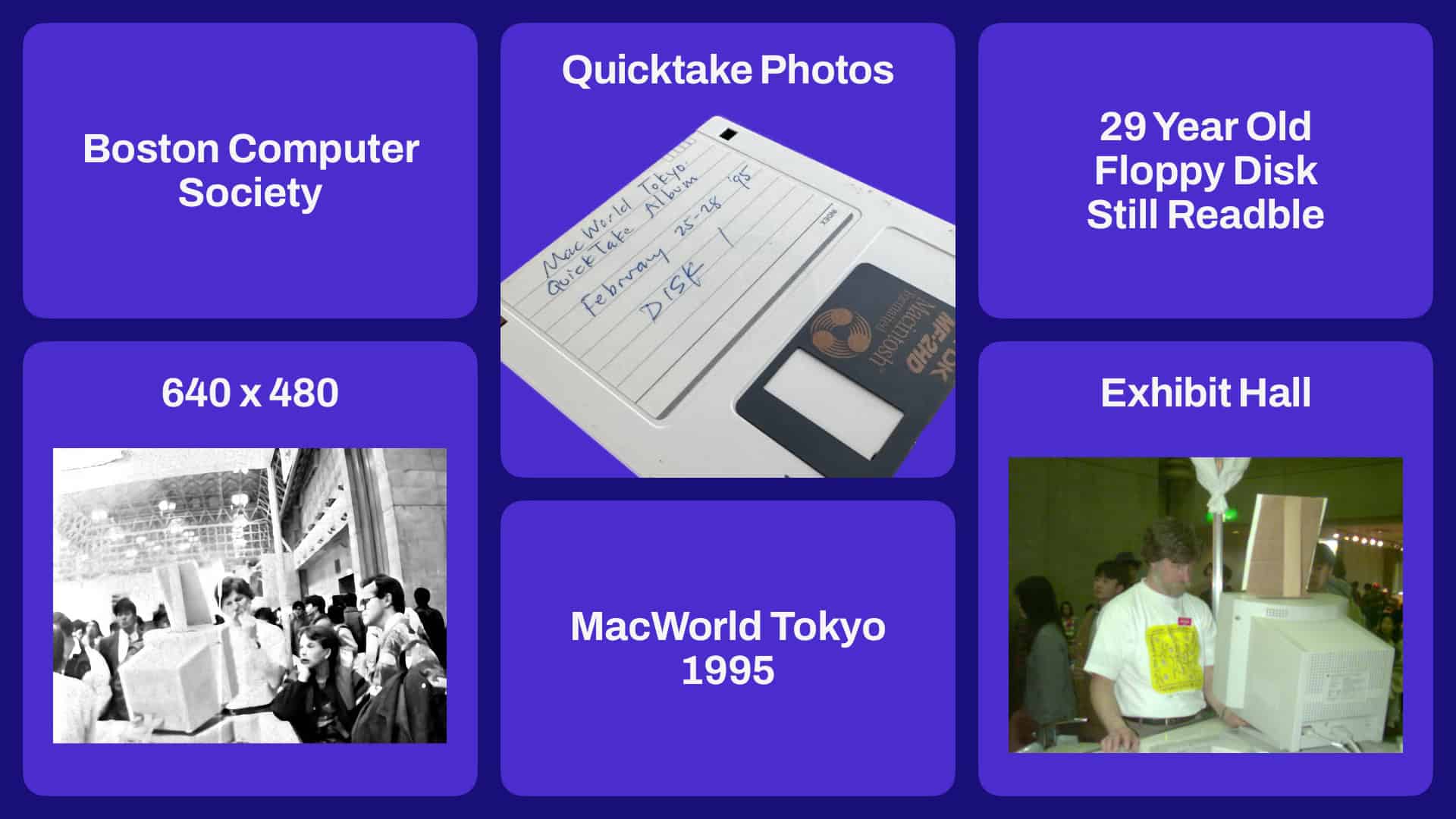
Last month, as I was cleaning up my closet, I stumbled upon a trove of old floppy disks. Among them was a particularly intriguing one given to me many years ago. This disk contains a treasure trove of photos from the 1995 MacWorld show in Tokyo. The photos were taken by a volunteer from the Boston Computer Society, a non-profit organization dedicated to helping people learn about computers. Their booth at MacWorld Tokyo was a hub of excitement, and someone armed with an Apple QuickTake 200 Camera captured the vibrant atmosphere of the exhibit hall.
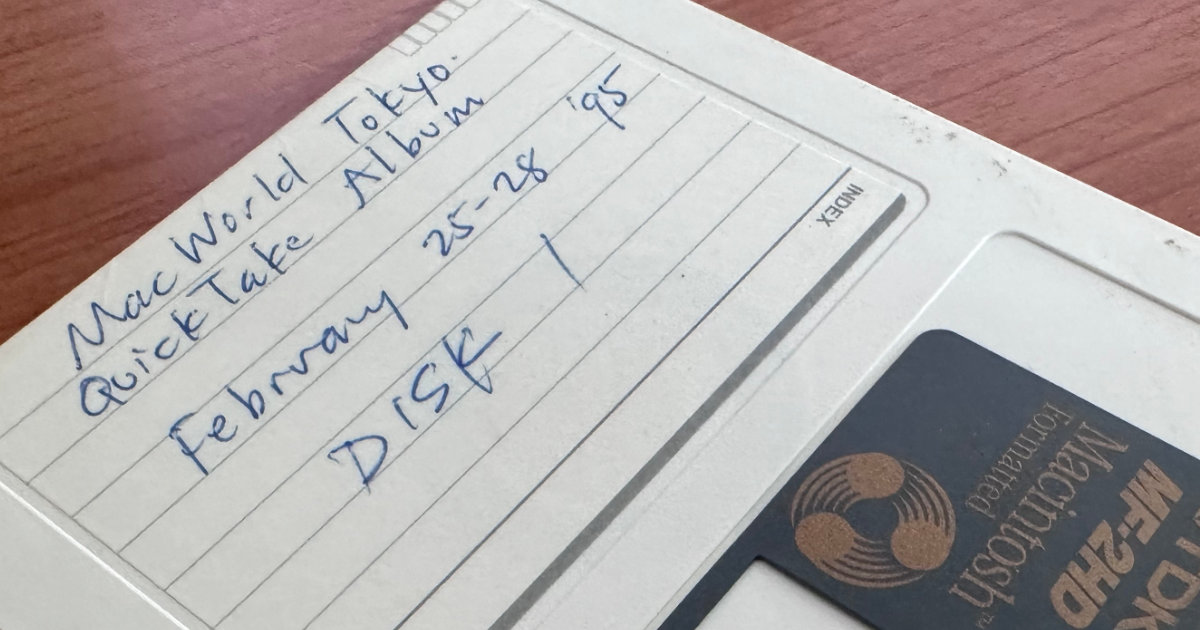
One of the floppy disks that I found. This just shows how importaint it is to label media files.
Four Things I Learned from This Find
1. The Apple QuickTake 200 Camera
The Apple QuickTake 200, an early digital camera, was used to capture the photos. It produced images with a resolution of 640 x 480 pixels, and each photo was about 121 KB in size. In today's world of multi-megapixel cameras, it's fascinating to see how far technology has come.
2. Converting QuickDraw Format
The photos were stored in QuickDraw format, which isn't easily viewable using modern software like Apple Preview. I had to use Graphic Converter to convert these images into a more accessible format. It's a reminder of how much digital formats have evolved over the years and the importance of preserving old software tools.
3. The Longevity of Floppy Disks
I found three floppy disks from the trade show, and only one of them wasn't working. Considering these disks are 29 years old, it's quite impressive that the other two were still readable. It's a testament to the durability of floppy disks, despite their limited storage capacity by today's standards.
4. A Piece of History: The 1995 MacWorld Expo Tokyo Poster
While exploring this find, I discovered that the 1995 MacWorld Expo Tokyo poster is selling for $95 on eBay. I have a copy, and the backside of the poster features a young Bill Gates, just months before the announcement of Windows 95. This poster is not just a piece of memorabilia; it's a snapshot of a pivotal moment in tech history.
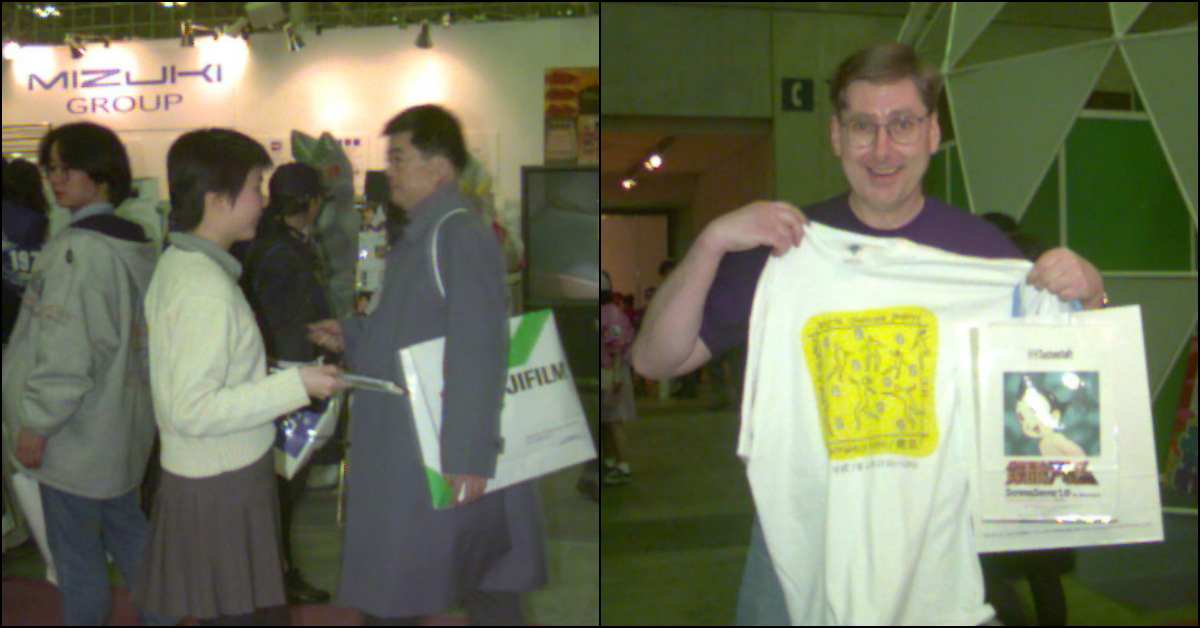
A couple of people that I found on the floppy disk.I used Pixelmator to increase the resolution.
Reflecting on MacWorld Tokyo 1995
MacWorld Tokyo 1995 was a significant event, bringing together tech enthusiasts and industry pioneers from around the world. The Boston Computer Society's presence at the event highlighted the importance of community and education in the rapidly evolving world of technology. The photos I uncovered provide a glimpse into that era, capturing the excitement and innovation that defined the mid-90s tech scene.
Preserving Digital Memories
Finding these photos and being able to convert and view them again was a nostalgic and enlightening experience. It underscores the importance of preserving our digital past, even as we move forward into an increasingly digital future. Each floppy disk, each photo, and each piece of memorabilia from events like MacWorld Tokyo 1995 is a valuable artifact that tells the story of our technological journey.
As I continue to explore and digitize these old floppy disks, I look forward to uncovering more hidden gems and sharing them with you. Stay tuned for more adventures in digital archaeology!
Do you have any memories from MacWorld Tokyo 1995 or similar events? Have you ever stumbled upon old digital media that brought back a flood of memories? Share your stories in the comments below!
PermalinkThe Web Tools CD for Macintosh
Classic CD Collection that has some use today
A few years ago, I came across an invaluable resource that quickly became a staple in my digital toolkit?the Web Tools CD for Macintosh. This CD, rich with Internet graphic files, provided a treasure trove of design elements that were both versatile and user-friendly. Let's take a walk down memory lane and explore what made this CD so special.
Unpacking the Web Tools CD
The Web Tools CD was more than just a collection of graphic files; it was a comprehensive resource designed to enhance the web design experience. Here?s a snapshot of the ReadMe file that accompanied the CD, highlighting some important operational notes and guidelines:
- Compatibility Considerations:
WebTools? was designed to operate optimally without the use of RamDoubler or Virtual Memory. Users were advised to turn these extensions off before launching the software to avoid any performance issues. - QuickTime Integration:
For maximum functionality on both Mac and Windows platforms, installing QuickTime was recommended. The CD conveniently included Mac QuickTime 2.1 and QuickTime for Windows 2.01 in the Extras folder, ensuring that users had everything they needed right out of the box. - Enhanced Visuals:
To enjoy the vibrant 24-bit color graphics, users needed to set their monitors to 24-bit color mode and launch WebTools while holding down the Option key. This simple step unlocked the full potential of the CD's graphical content. - Usage and Licensing:
All design elements on the disk were freely available for incorporation into web pages. However, there was a stipulation that these elements could not be offered as downloadable files. For detailed information, users were directed to the ?Copyright and Licensing Information? chapter of the manual.

The Value of Web Tools CD
The Web Tools CD stood out for several reasons:
- Rich Graphic Library:
It offered a diverse range of graphic files, including icons, backgrounds, and other design elements that were essential for creating visually appealing web pages. - Ease of Use:
The CD was user-friendly, making it accessible even for those who were not professional designers. The inclusion of QuickTime ensured smooth operation across different platforms. - Creative Freedom:
Users had the freedom to incorporate the design elements into their web pages without worrying about licensing issues, provided they adhered to the guidelines. - Technical Support:
The ReadMe file and manual provided clear instructions and troubleshooting tips, making it easy to get the most out of the CD.
Reflecting on the Experience
Looking back, the Web Tools CD was more than just a product; it was a creative enabler. It allowed web designers, both amateur and professional, to enhance their projects with high-quality graphics and intuitive tools. The careful attention to detail in the ReadMe file, along with the thoughtful inclusion of necessary software like QuickTime, showcased the creators' commitment to providing a seamless user experience.
In today's digital age, where we have a plethora of online resources and cloud-based tools, it's easy to forget the charm and utility of physical media like the Web Tools CD. However, for those of us who had the opportunity to use it, it remains a fond reminder of the early days of web design and the innovative spirit that drove the development of such resources.
Whether you're a nostalgic tech enthusiast or a curious web designer looking to explore the roots of web design, the Web Tools CD is a fascinating piece of digital history worth remembering.
PermalinkPowerbook G3 "WallStreet" Reset
Easy Instructions on the Computer
When we think about the evolution of laptops, certain models stand out for their innovation and impact. Among these, the Powerbook G3 "WallStreet," released by Apple in 1998, holds a special place in the hearts of tech enthusiasts. As a proud owner of this classic machine, I'm excited to share some fascinating details about its design and features that set it apart from its contemporaries.
A Brief History
The Powerbook G3 series was a significant leap in laptop technology during the late '90s. It was known for its powerful performance, sleek design, and advanced features that made it a favorite among professionals and tech aficionados. The "WallStreet" model, in particular, was named after the famous financial district, symbolizing its robust capabilities and cutting-edge technology.

Unique Features of the Powerbook G3 "WallStreet"
One of the most distinctive features of the Powerbook G3 "WallStreet" is its built-in reset instructions. This thoughtful inclusion reflects Apple's user-centric design philosophy, even in the early days of their laptop innovations.
PermalinkMacUser Instant Replay
System 7 App by Mike Throckmorton
In the mid-1990s Mike Throckmorton created a tool call "Instant Replay." It was distributed by MacUser magazine. I wasn't able to find the actual tool, but I did find the ReadMe file.
The tool only works in System 7.
About MacUser's Instant Replay
When you press its hot-key, Instant Replay repeats either the last menu command you selected (by way of the mouse) or the last series of keystrokes you typed. Command-key menu selections count as keystrokes so Cmd-C (Copy) for example, would be included as part of a key-stroke sequence.
Operation
Like I already said up there, Instant Replay repeats either the last menu command you selected (using the mouse) or the last series of keystrokes you typed. Command-key menu selections count as keystrokes so Cmd-C (Copy) for example, would be included as part of a key-stroke sequence.
If the series of keystrokes you've typed since the last menu-selection don't meet your needs (or if you are thinking ahead and wish to "record" a specific set of keystrokes) you'll need to "clear" the keystroke buffer by holding down the shift key (either one) and typing the Instant Replay hot key. For example, if your Instant Replay hot-key is Control-~, then you would hold down shift-Control-~ to clear the keystroke buffer.
You can set the Instant Replay hot-key using the Instant Replay control panel. Simply invoke the Control panel and press a key-stroke combination to set the hot-key.
Currently, the keystroke buffer holds 256 keystrokes.
If you invoke Instant Replay to instantly replay and you discover that it is replaying all kinds of stuff you forgot and you want to tell it to "Stop! Stop!" you can do so by holding down the Command key and pressing "." (the period key).
Instant Replay is not QuicKeys. It is not Tempo. It is intended simply to repeat a simple set of key-strokes or a menu command without having to become a scripting whiz-kid. It is limited in capability and function but is also, therefore, limited in complexity and the brain power required to use it.
Which makes it perfect for people like me.
About The Author
I'm an old guy, born Feb. 6, 1953 but my brain was frozen in time (some might say just in time) during elementary school. So my sense of humor never made it to the level of maturity commonly known as "sophomoric". Perhaps "sub-pre-moronic" or simply "sickeningly stupid". One of my eldest daughter's first spoken thoughts was "No jokes, Daddy". Which is an amazing coincidence because her name is Victoria and one of Queen Victoria's most famous quotes "We are not amused" pretty well sums up her attitude.
Although at this stage of the game irrelevant, I have a B.S. in mathematics (real math, mind you, I was on my way to a PhD when I bugged out in favor of computers) and an M.S. in Computer Science. Since college, I have: supported mainframe operating systems, large corporate databases, large corporate networks, developed big online application systems, network operating systems, network software for workstations and mainframes, preemptive OS's for PC's, communications drivers, and on and on and on (I've never written a game program, though, hmmmmm....). Presently, I work part-time developing medical imaging software, doing Ziffware and other freelance programming.
I am married, am possessed by 3 kids (all girls) and am the only male in the house besides 5 neutered male cats (I take the hint and watch my step). I spend a lot of time doing community volunteer kinds of things (for example, I'm a Girl Scout leader, gasp). For exercise, I ride my mountain bike every where I can and play roller-blade basketball (useful tip: when driving for a fast-break lay-up, swoop in from the side rather than driving directly at the basket...those steel support poles are hard).
PermalinkAbout
Remembering some classic Macintosh Hardware and Software from the early 1990s and 2000s.
Check out all the blog posts.
Schedule
| Saturday | Internet Tools |
| Sunday | Open Topic |
| Monday | Media Monday |
| Tuesday | QA |
| Wednesday | New England |
| Thursday | Gluten Free |
| Friday | Macintosh |
Other Posts
- Rediscovering the eWorld Font
- Exploring the Classic Macintosh Game: Bub & Bob
- MacUser Instant Replay
- Fonts By David Rakowski
- Total Training for Adobe PageMaker 7
- Xavier Font
- Art Parts
- Info-Mac CD
- 101,000 Image Collection
- Rediscovering MacWorld Tokyo 1995
- The Web Tools CD for Macintosh
- Dual-1.42GHz Power Mac G4
- Discovering eWorld Floppy Disks
- Macintosh 9: Finder: View as Button
- Classic Mac Posts